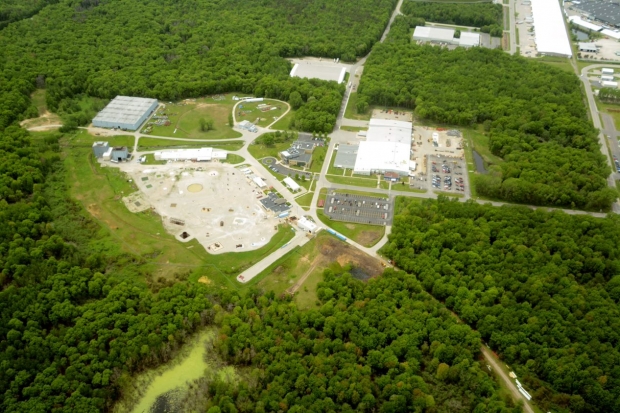DNR Wants Johnson Controls to Test More Fish for PFAS
Some ponds have fish with levels of PFAS that would require restrictions on eating fish.

An aerial photo of Tyco’s Fire Training Center in Marinette. Photo from Johnson Controls International.
State environmental regulators are asking a Marinette manufacturer of firefighting foam to expand sampling of fish for chemicals known as PFAS. The move comes after sampling in private ponds near Tyco’s fire training facility showed fish had PFAS concentrations that would trigger restrictions on eating fish.
Tyco, a subsidiary of Johnson Controls International (JCI), sampled three private ponds near its fire technology center in Marinette as part of an ongoing investigation into PFAS contamination stemming from its facility. The site has been used for research, testing and training with firefighting foam that contains the chemicals, which don’t break down easily and are linked to health issues, including some cancers.
The Wisconsin Department of Natural Resources (DNR) is not issuing a fish consumption advisory because the ponds are not accessible to the public, according to Christine Haag, the agency’s remediation and redevelopment director.
“But we do have concerns about what was found in the fish from those ponds that don’t have public access,” said Haag. “And, so, we have asked JCI/Tyco to submit a work plan to the DNR that evaluates fish from other water bodies, including water bodies that have public access.”
Fish samples from the ponds showed PFAS concentrations ranging from .67 to 144 parts per billion (ppb). The owners of the private ponds have been notified of the results, according to Katie McGinty, chief sustainability officer for Johnson Controls.
“These results show us — like a bunch of other data we’ve recently collected — the closer to our property, the higher you’re going to see those levels,” said McGinty.
Some of the 16 fish samples would trigger restrictions on eating fish no more than once a week or once a month. McGinty emphasized that none of the fish sampled, which included bluegills, large-mouth bass and yellow perch, had PFAS levels that would warrant a “Do Not Eat” advisory under the GLC guidelines. Ten fish had concentrations that would require no restrictions on consumption.
Haag noted it’s important to expand fish sampling in the area because people could potentially become exposed to PFAS by eating fish.
Tyco submitted a sampling plan to the DNR on Nov. 5 that would provide fish tissue data on five privately-owned ponds. The expanded sampling does not include plans to collect data from the Menominee River and Green Bay. The plan said they would not be sampled since the U.S. Environmental Protection Agency and DNR have already collected fish tissue samples from those waters.
McGinty said there aren’t many publicly accessible waterways in the area that would be impacted by PFAS from the fire training facility.
“As you begin to step back and take the picture of what public waterways exist in the area that has PFAS in it from our property in that area, the main body of water that would be potentially accessible to the public is Ditch B,” said McGinty.
McGinty said the company has been able to pinpoint that PFAS is moving through groundwater east of the facility, which will guide efforts to address the problem.
The Wisconsin Department of Health Services has recommended a combined groundwater standard of 20 parts per trillion for six PFAS chemicals, including PFOA and PFOS. The EPA has yet to develop a federal drinking water standard, but the agency has issued a health advisory of 70 parts per trillion.
The DNR is currently reviewing the company’s plan for expanded fish sampling around the facility.
DNR Asks Tyco To Expand Sampling Of Fish For PFAS was originally published by Wisconsin Public Radio.
If you think stories like this are important, become a member of Urban Milwaukee and help support real, independent journalism. Plus you get some cool added benefits.
More about the PFAS Problem
- Bipartisan Push to Tell Counties Faster When Water Tests Fail - Henry Redman - Dec 19th, 2025
- MKE County: County Seeks to Sue PFAS Producers, Oil Companies - Graham Kilmer - Dec 10th, 2025
- Wisconsin Reviewing EPA-Approved Pesticides For PFAS - Danielle Kaeding - Dec 9th, 2025
- State Nears Settlement with Johnson Controls/Tyco Over PFAS Spills - Danielle Kaeding - Dec 4th, 2025
- Senate Bill Promotes Soybean-Based Firefighting Foam to Replace PFAS - Danielle Kaeding - Dec 2nd, 2025
- Test Results Show High PFAS Levels in Wisconsin’s Landfill Runoff - Danielle Kaeding - Dec 2nd, 2025
- Wisconsin Communities Get $282 Million for Drinking Water Projects - Danielle Kaeding - Nov 19th, 2025
- Gov. Evers, DNR Announce $282 Million to Improve Drinking Water Quality for Wisconsinites in 74 Municipalities - Gov. Tony Evers - Nov 18th, 2025
- Cleanup of PFAS Could Cost Wisconsin Billions - Danielle Kaeding - Nov 13th, 2025
- Cleanup PFAS Without Penalizing Innocent Landowners - Wisconsin Manufacturers & Commerce - Nov 4th, 2025
Read more about PFAS Problem here



















